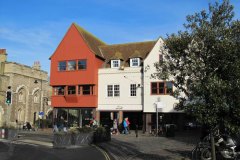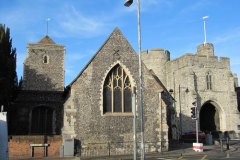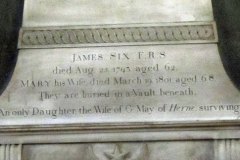Silk Weaver & Inventor of the Maximum-Minimum Thermometer
James Six was born in 1730, son of James and Ester Six, members of the Walloon community in Canterbury. After a period in the declining family silk weaving business, he devoted his time to scientific experiments, particularly in the fields of astronomy and meteorology. Despite no formal training in these fields, James achieve fame through his work on the maximum-minimum thermometer. Others before him had looked into ways of measuring maxima or minima of temperatures over a given period, but, in 1780, James succeeded in producing a single simple instrument which could reliably record both. A description appeared in the Royal Society journal that year, and quickly acquired international interest. James was elected a Fellow of the Royal Society in 1792. To this day, modern versions of the same apparatus are widely used in horticulture, climatology, houses and greenhouses. James never patented his invention. He died in 1793 and is buried with his wife Mary in a vault in Holy Cross church by the Westgate. His scientific interests went much wider than thermometers – in 1781 he reported the comet he’d discovered ‘on the tip of the left hinder paw of the Little Bear’.
Detailed wills for James the inventor, and for James his father, survive in the National Archives. The Six family home is described in the father’s will as being ‘in or near a certain Lane called Pound Lane’ with ground known as ‘the wells’ adjoining ‘the bowling green’. The location of the wells is known to have been on the site of the present Pound Lane car park, so it seems a reasonable conjecture that the Six family home stood close to the modern Barratt’s showroom. The site later became the ‘Exotic Gardens’ run by William Masters – Royal Society archives show James as a florist amongst other things. James (the inventor) was a major benefactor of Holy Cross and funded purchase of their new organ. He also introduced Sunday Schools to Holy Cross when these were a novelty. He is summarised by Anita McConnell in ODNB as ‘a competent yet modest and unassuming man of great integrity, and a devout Christian’.
What to see
- The former Barretts showroom marks (roughly) the site of the Six family property (Image 1)
- Holy Cross church, now the Canterbury District Council Guildhall (Image 2)
- Memorial to James Six (Image 3) in Holy Cross church – no mention of his thermometer!
Sources: Six (1794); ODNB; Gentleman’s Magazine vol. 57 part 1 p18; Notes and records of the Royal Society vol.35, no. 1 July 1980 (article by Jillian F Austin and Anita McConnell); wills available on line at National Archives (PROB 11/667 and 11/1237); for the new comet see St James’ Chronicle 13 November 1781; for introduction of Sunday Schools see St James’ Chronicle 16 February 1786
DL



